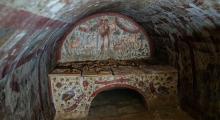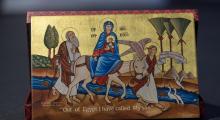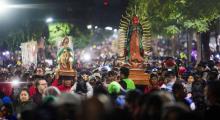Issued by the Catholic Center for Studies and Media - Jordan. Editor-in-chief Fr. Rif'at Bader - موقع أبونا abouna.org

“What if even a fraction of these alleged Marian apparitions were real?”
Such a question might be inspired by a glimpse at the very first pages of the newly published in English book from Sophia Institute Press, The World of Marian Apparitions, by Polish author and Mariologist Wincenty Łaszewski. It begins with an impressive map that in a graphical way sets the stage for an unprecedented visual exploration into the modern history of Marian apparitions.
Visions of the Virgin Mary continue in our current day to be of great interest to Marian devotees and miracle-minded Catholics. This book opens the door to the consideration of a panoply of modern cases that have already been fully investigated and judged by the Catholic Church, are in process or may be considered at some point in the near future.
In an attempt to understand the world of Marian apparitions claimed throughout Christian history and document them on my website MiracleHunter.com, and as part of being a host of an EWTN Radio programthat frequently tackles the topic, I have acquired just about every modern major book (and plenty of older, obscure and smaller ones) ever written on the topic. While some scholarly encyclopedic compilations or classic Fatima books will always have a certain appeal to me, I find The World of Marian Apparitions to be perhaps the greatest visual compilation of modern Marian apparitions ever assembled.
While some content choices and approaches of the book present certain challenges for me and leave me with questions, overall this work stands alone for its thorough and visually-stunning treatment of a topic of such great interest to so many Catholics.
The World of Marian Apparitions excels in many ways. It is beautifully laid out with a wealth of captivating photography and classic artwork, even in documenting the locations of remarkable apparitions unknown to Americans but with a local devoted following dedicated over decades. Visually, the book takes the reader to these locations so that they might experience each of these important and rare moments in the history of the Church. Each chapter features maps and text call outs to give context to the vision and highlights the shrines and devotions that have arisen out of these miraculous back stories.
Photos and brief biographical sketches of the visionaries for each case are presented as well some of the significant messages attributed to the Virgin Mary at each location. The book is written in a light, but engaging, devotional style that presents the facts of these cases while capturing the tenderness of the realized intention of the Mother of God over the centuries to be physically present to care for her children.
The number of little-known cases presented will be eye-opening for most readers. While most books on Marian apparitions will focus only on the most highly approved and easily recognizable cases for the average Catholic (e.g., Lourdes and Guadalupe), this book goes well beyond that with numerous instances of Marian miracles that even the most avid apparition aficionado will likely not be aware of. Of the 48 cases that have a chapter dedicated to them in this work, likely three-quarters of the entries will be new to the vast majority of readers, even to those with a deep interest in this topic.
There are chapters on the initial apparitions of Fatima and the later visions reported by Sister Lúcia along with entries on the Vatican-recognized instances of Beauraing (1932), Banneux, Belgium (1933) and Kibeho, Rwanda (1981). People might be familiar with the Coptic case where the Virgin Mary was seen by crowds on the rooftop of a church in Zeitoun, Egypt (1968-1971), the supernatural experiences of mystic Servant of God Maria Esperanza de Bianchini in Betania, Venezuela, or the weeping statue of Akita, Japan (1973). Heede, Germany (1937), Ngome, South Africa (1955), Kurescek, Slovenia (1989), Litmanova, Slovakia (1990), and Aokpe, Nigeria (1992) are but a handful of the lesser-known alleged apparitions of the Virgin Mary that are covered in depth in this book. Several very modern cases into the 2000s are included as well as a couple of cases from the United States.
Overall, the thorough coverage of modern history’s most significant cases is extraordinary and the depth of presentation is commendable. It makes a valiant attempt to include just about every significant Marian apparition with at least a shred of potential of being authentic claimed over the last century and a half and represent the full spectrum of visionary experiences. They range from the fully Church-approved and promoted (e.g. Our Lady of the Rosary in Fatima, Portugal 1917) to once-approved apparitions that later received a negative judgment by the Church (Our Lady Mediatrix of All Grace in Lipa, Philippines in 1947).
In order to assist the reader in understanding the extent to which the Church has investigated and judged each apparition, The World of Marian Apparitions uses a graphical coding system introduced early in the volume which establishes the levels of Church recognition given to each of the cases. At the beginning of each chapter, the relevant icons are displayed on the entry title page below the city and year.
A word of caution however: The system does not include symbols for negative judgments rendered by the Church, but only the furthest extent of the positive approvals. If an apparition were to be initially shown favor by ecclesiastical authorities and later rejected or discouraged, only the positive progress is indicated by the symbols in this book.
While certainly a more inspirational and positive offering than if it were also to present the negative judgments of the Church, the book does not always visually paint the most complete picture of an alleged apparition’s standing within the Church.
Amongst the icons appropriately included are those indicating the recognition by the Vatican and local bishops, the visionary being a saint (or being considered for sainthood), or a pope visiting the site, all of which are signs that the Church is in full support of a claimed Marian apparition. Other key developments like an imprimatur(i.e. nothing found contrary to faith and morals) given to the apparition messages or the building of a shrine or public devotion formally permitted at the site are represented as well.
Some symbols might be confusing to the reader and not indicative of any official status within the Church, namely, “miracles at the apparition site” (authorized by whom?) and “a revelation accepted by the belief of pilgrims” (which pilgrims?). Several apparitions are included that have not been declared definitively supernatural or received encouragement from the local bishop for the associated devotion. The careful reader might pay close attention to the assigned symbols for each case and, due to some chapters lacking acknowledgement of the legitimate concern of the Church, even perform outside research to get a full picture of the status of a particular vision.
This less rigorous presentation of the to-the-letter approval status and lighter writing style reflect the intention of the book to broaden the audience of Marian devotees in specific and among the Catholic faithful as more of a story-telling work rather than an encyclopedic book with academic precision. Along those lines, the book makes little or no distinction in reporting the words of the Virgin Mary in Church-sanctioned apparitions versus alleged words attributed to her in unapproved apparitions. I always like to know if the quotes are things that the Mother of God has actually said, or things she might have said — so for me, paying attention to the approval status and graphical indicators in this book is very important.
Despite my reservations, which are related to my primary concern with acknowledging official Church judgments and guidance, I find Wincenty Łaszewski’s beautiful book The World of Marian Apparitions to be a spectacular and eye-opening treatment of this most fascinating topic.







